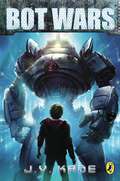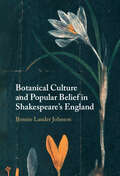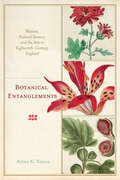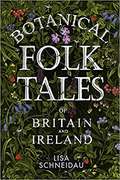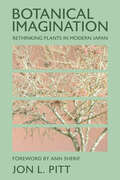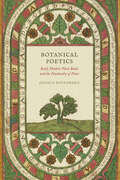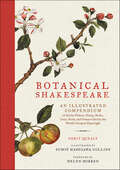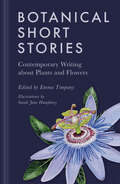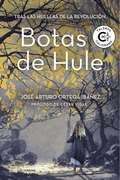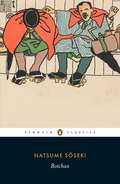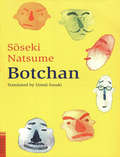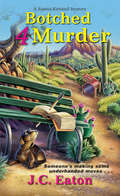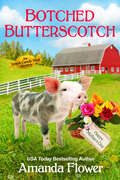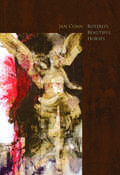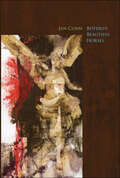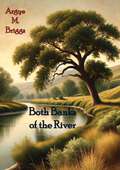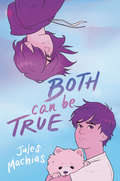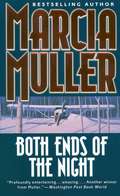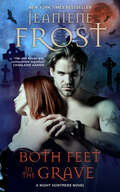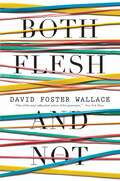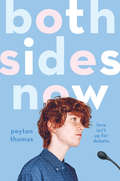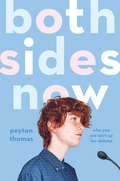- Table View
- List View
Bot Wars
by J. V. KadeTwelve-year-old Trout St. Kroix has been searching for his missing father for the last two years, after his dad disappeared while fighting in the Bot Wars. The Bot Wars began after robots became so advanced that they revolted and demanded more workers' rights, causing the government to declare all robots terrorists and ban them from the Districts. Trout never questioned anything the government told him--even when his own nanny bot was banished--until a vid he posts about his missing dad goes viral and new information pops up. At first Trout is wrenched his dad might be alive, but when his brother disappears, Trout learns nothing is what it seems . . . not even his own father. Percy Jackson meets Transformers in this heart-stopping, futuristic adventure that will make you question everything you know--and look at robots in a whole new light.
Botanical Culture and Popular Belief in Shakespeare's England
by Bonnie Lander JohnsonThe Shakespearean stage offered London playgoers a glimpse of the illiterate and rural plant cultures rapidly disappearing from their increasingly urban and sophisticated lives. The same cultures also circulated in popular texts offstage: bawdy tree ballads, botanical tales, almanacs and accounts of kitchen physic. Here Bonnie Lander Johnson argues that, while Shakespeare's plants offered audiences a nostalgic vision of childhood, domestic education and rural pastimes, this was in fact done with an ironic gesture that claimed for illiterate culture an intellectual relevance ignored by the learned and largely Protestant realm of print. Addressing a long-standing imbalance in early modern scholarship, she reveals how Shakespeare's plays – and the popular, low botanical beliefs they represent – engaged with questions usually deemed high, literate and elite: theological and liturgical controversies, the politics of state, England's role in Elizabethan naval conflict and the increasingly learned realm of medical authority.
Botanical Entanglements: Women, Natural Science, and the Arts in Eighteenth-Century England
by Anna K. SagalTo this day, women face barriers in entering scientific professions, and in earlier eras the challenges were greater still. But in Botanical Entanglements, Anna Sagal reveals how women’s active participation in scientific discourses of the eighteenth century was enabled by the manipulation of social and cultural conventions that have typically been understood as limiting factors. By taking advantage of the intersections between domesticity, femininity, and nature, the writers and artists studied here laid claim to a specific authority on naturalist subjects, ranging from botany to entomology to natural history more broadly.Botanical Entanglements pairs studies of well-known authors—Eliza Haywood, Charlotte Lennox, Maria Edgeworth, and Charlotte Smith—with authors and artists who receive less attention in this context—Priscilla Wakefield, Maria Jacson, Elizabeth Blackwell, Henrietta Maria Moriarty, and Mary Delany—to offer a nuanced portrait of the diverse strategies women employed to engage in scientific labor. Using socially acceptable forms of textual production, including popular periodicals, didactic texts, novels, illustrated works, craftwork, and poetry, these women advocated for more substantive and meaningful engagement with the natural world. In parallel, the book also illuminates the emotional and physical intimacies between women, plants, and insects to reveal an early precursor to twenty-first-century theorizing of plant intelligence and human-plant relationships. Recognizing such literary and artistic "entanglement" facilitates a more profound understanding of the multifaceted relationship between women and the natural world in eighteenth-century England.
Botanical Folk Tales
by Lisa SchneidauThis collection of folk tales takes you on a green and leafy journey around the British Isles. Here are locally sourced and traditional folk tales of wild trees and plants throughout the seasons: from the magical mistletoe to the bad-tempered stinging nettle. Plants shape the British landscape, and they provide food, medicine and inspiration—yet in the middle of our hectic lives, we often take them for granted. Traditional stories, passed down the generations, tell of the complex relationship between people and plants in Britain, in lowlands and uplands, coasts, bogs, forests, and towns.
Botanical Imagination: Rethinking Plants in Modern Japan (The Environments of East Asia)
by Jon L. PittBotanical Imagination explores the complicated legacy and enduring lure of plant life in modern Japanese literature and media. Using critical plant studies, Jon L. Pitt examines an unlikely group of writers and filmmakers in modern Japan, finding in their works a desire to "become botanical" in both content and form. For nearly one hundred years, a botanical imagination grew in response to moments of crisis in Japan's modern history.Pitt shows how artists were inspired to seek out botanical knowledge in order to construct new forms of subjectivity and attempt to resist certain forms of state violence. As he follows plants through the tangled histories of imperialism and state control, Pitt also uncovers the ways plants were used in the same violence that drove artists to turn to the botanical as a model of resistance in the first place. Botanical Imagination calls on us to rethink plants as significant but ambivalent actors and to turn to the botanical realm as a site of potentiality.
Botanical Poetics: Early Modern Plant Books and the Husbandry of Print
by Jessica RosenbergDuring the middle years of Queen Elizabeth’s reign, the number of books published with titles that described themselves as flowers, gardens, or forests more than tripled. During those same years, English printers turned out scores of instructional manuals on gardening and husbandry, retailing useful knowledge to a growing class of literate landowners and pleasure gardeners. Both trends, Jessica Rosenberg shows, reflected a distinctive style of early modern plant-thinking, one that understood both plants and poems as composites of small pieces—slips or seeds to be recirculated by readers and planters.Botanical Poetics brings together studies of ecology, science, literary form, and the material text to explore how these developments transformed early modern conceptions of nature, poetic language, and the printed book. Drawing on little-studied titles in horticulture and popular print alongside poetry by Shakespeare, Spenser, and others, Rosenberg reveals how early modern print used a botanical idiom to anticipate histories of its own reading and reception, whether through replanting, uprooting, or fantasies of common property and proliferation. While our conventional narratives of English literary culture in this period see reading as an increasingly private practice, and literary production as more and more of an authorial domain, Botanical Poetics uncovers an alternate tradition: of commonplaces and common ground, of slips of herbs and poetry circulated, shared, and multiplied.
Botanical Shakespeare: An Illustrated Compendium of all the Flowers, Fruits, Herbs, Trees, Seeds, and Grasses Cited by the World's Greatest Playwright
by Gerit QuealyA captivating, beautifully illustrated, one-of-a-kind color compendium of the flowers, fruits, herbs, trees, seeds, and grasses cited in the works of the world’s greatest playwright, William Shakespeare, accompanied by their companion quotes from all of his plays and poems. With a foreword by Dame Helen Mirren—the first foreword she has ever contributed.In this striking compilation, Shakespeare historian Gerit Quealy and respected Japanese artist Sumié Hasegawa combine their knowledge and skill in this first and only book that examines every plant that appears in the works of Shakespeare.Botanical Shakespeare opens with a brief look at the Bard’s relationship to the plants mentioned in his works—a diversity that illuminates his knowledge of the science of botany, as well as the colloquy, revealing his unmatched skill for creating metaphorical connections and interweaving substantive philosophy. At the heart of the book are "portraits" of the over 170 flowers, fruits, grains, grasses, trees, herbs, seeds and vegetables that Shakespeare mentions in his plays and poems. Botanical Shakespeare features a gorgeous color illustration of each, giving a "face" to the name, alongside the specific text in which it appears and the character(s) who utter the lines in which it is mentioned.This fascinating visual compendium also includes a dictionary describing each plant—such as Eglantine, a wild rose with a slight prickle, cherished for its singular scent, superior to any other rose; and the difference between apples and apple-john—along with indices listing the botanical by play/poem, by character, and genus for easy reference, ideal for gardeners and thoughtful birthday gift-giving.This breathtaking, incomparable collection of exquisite artwork and companion quotes offers unique depth and insight into Shakespeare and his timeless work through the unusual perspective of the plants themselves.
Botanical Short Stories: Contemporary Writing about Plants and Flowers
by Emma TimpanyA unique collection of contemporary short stories exploring our deep attachment to flowers and plants and the meanings they hold
Botas de Hule: Tras las huellas de la revolución
by José Arturo Ortega IbáñezUn relato trepidante que nos recuerda que la fe y la voluntad definen los momentos más cruciales de nuestras vidas. 1979. Irune, miembro de ETA, huye a Nicaragua tras perpetrar un atentado en la casa cuartel donde vivía su propia familia. <P><P>El gobierno sandinista la acoge y la envía como enfermera a un remoto hospital que está en construcción en medio de la selva. Para su sorpresa, Irune se encontrará allí con su prima Isabela, a quien no ve desde hace años. Pese a la distancia, ambas han llevado vidas paralelas, y al cabo de peligros y aventuras, acabarán también juntas en las cumbres del Cauca, al sur de Colombia, combatiendo como guerrilleras del M19. <P>Los ideales revolucionarios, los sentimientos de culpa, la búsqueda del amor y el arduo camino hasta la adultez entrelazan este relato trepidante que nos recuerda que la fe y la voluntad definen los momentos más cruciales de nuestras vidas.
Botchan
by Natsume Soseki Umeji SasakiOne of Japan's most popular novels, this timeless tale of a changing society combines old idealism with modern independence. Written in 1906 and loosely based on the author's life, it recounts the experiences of a teacher who moves from Tokyo to an isolated town. Botchan -- rash and impulsive in his actions, direct and frank in his speech -- is an especially popular figure with young readers, although the Times Literary Supplement noted, "This rollicking rebel, and the spice and pace of the narrative, will appeal to parent, teacher, and schoolchild alike." This edition offers an excellent translation of the author's poetic prose.
Botchan
by Natsume SosekiBotchan is a modern young man from the Tokyo metropolis, sent to the ultra-traditional Matsuyama district as a Maths teacher after his the death of his parents. Cynical, rebellious and immature, Botchan finds himself facing several tests, from the pupils - prone to playing tricks on their new, naïve teacher; the staff - vain, immoral, and in danger of becoming a bad influence on Botchan; and from his own as-yet-unformed nature, as he finds his place in the world. One of the most popular novels in Japan where it is considered a classic of adolescence, as seminal as The Catcher in the Rye, Botchan is as funny, poignant and memorable as it was when first published, over 100 years ago.In J. Cohn's introduction to his colourful translation, he discusses Botchan's success, the book's clash between Western intellectualism and traditional Japanese values, and the importance of names and nicknames in the novel.
Botchan (Tuttle Classics)
by Natsume Soseki Dennis WashburnA modern classic in Japan on par with The Adventures of Huckleberry Finn or The Catcher in the Rye, Botchan is a very popular Japanese novel and still widely read decades after its first publication.Botchen, a timeless Japanese novel written by Japan's most beloved novelist, Soseki Natsume, is now available in a revised edition featuring a new foreword by Dennis Washburn, Professor of Asian and Middle Eastern Languages at Dartmouth College. Prof. Washburn's foreword places the importance of both the author and the book into perspective for the modern reader.Botchan's story is a familiar one: the youngest son in a middle class Tokyo family, he is consistently in the shadow of his elder brother. With a practically nonexistent relationship with his family, Botchan finds himself cast adrift after both his parents die. Now on his own, Botchan drifts through college only to find himself thrust into a teaching job in the unfamiliar realm of a country school, far from Tokyo and the life he has known. Botchan's quest is to navigate society's hypocrisies while remaining true to what he believes is honest and good.
Botched 4 Murder (Sophie Kimball Mystery #4)
by J. C. EatonBowled over . . . Sophie “Phee” Kimball is getting dragged into the drama again at her mom’s Arizona retirement community. A new board member wants to get rid of two golf courses and replace them with eco-friendly parks, and some of the residents are pretty teed off about it. On top of that, her mother’s book club friend Myrna is being pushed out of the bocce league. These seniors are serious about winning, and Myrna’s dragging them down. She’s so bad at bocce, in fact, that when a community member’s dead body is discovered while Myrna’s practicing for a tournament, she assumes it was one of her own errant balls that killed the woman. But before Myrna can be tossed off the bocce court and into criminal court, the police find an arrow in the victim’s neck. It looks like this was no accident—and Phee and her investigator boyfriend Marshall will have to team up to bounce a killer into the slammer . . .
Botched Butterscotch (An Amish Candy Shop Mystery)
by Amanda FlowerA slice of intrigue. . . Mother&’s Day is a sweet and busy time at the candy shop Bailey King runs with her Amish grandmother. This year is extra special, because Bailey&’s parents are visiting Harvest, Ohio. Bailey&’s father has rarely returned since leaving the Amish faith over thirty years ago, but Bailey is confident that the right treats can help sugarcoat any awkwardness. For Mother&’s Day Tea at the local church, she&’s whipping up her mom&’s favorite: butterscotch fudge. All&’s going well, until a sticky-fingered thief makes off with the money raised for a local women&’s support group. While Bailey tries to discover who stuck their fingers in the cookie jar, she encounters an assortment of suspects. It doesn&’t help that Juliet, mother of Deputy Aiden Brody, is conspiring with Bailey&’s mom to plan Aiden and Bailey&’s wedding…though they&’re not even engaged! Can Bailey find the culprit before events—both criminal and personal—boil over into disaster? Recipe Included! Praise for Amanda Flower and her Amish cozies &“As it turns out, Amanda Flower may have just written the first Amish rom com.&” —USA Today &“Flower has hit it out of the ballpark . . . and continues to amaze with her knowledge of the Amish way of life.&” —RT Book Reviews &“At turns playful and engaging . . . a satisfyingly complex cozy.&” —Library Journal
Botched Butterscotch (An Amish Candy Shop Mystery)
by Amanda FlowerA slice of intrigue. . . Mother&’s Day is a sweet and busy time at the candy shop Bailey King runs with her Amish grandmother. This year is extra special, because Bailey&’s parents are visiting Harvest, Ohio. Bailey&’s father has rarely returned since leaving the Amish faith over thirty years ago, but Bailey is confident that the right treats can help sugarcoat any awkwardness. For Mother&’s Day Tea at the local church, she&’s whipping up her mom&’s favorite: butterscotch fudge. All&’s going well, until a sticky-fingered thief makes off with the money raised for a local women&’s support group. While Bailey tries to discover who stuck their fingers in the cookie jar, she encounters an assortment of suspects. It doesn&’t help that Juliet, mother of Deputy Aiden Brody, is conspiring with Bailey&’s mom to plan Aiden and Bailey&’s wedding…though they&’re not even engaged! Can Bailey find the culprit before events—both criminal and personal—boil over into disaster? Recipe Included! Praise for Amanda Flower and her Amish cozies &“As it turns out, Amanda Flower may have just written the first Amish rom com.&” —USA Today &“Flower has hit it out of the ballpark . . . and continues to amaze with her knowledge of the Amish way of life.&” —RT Book Reviews &“At turns playful and engaging . . . a satisfyingly complex cozy.&” —Library Journal
Botero's Beautiful Horses
by Jan Conn“Do we want love / each and every day of our lives?” Jan Conn asks in a poem called “Michoacán.” “You bet your ass,” she answers. The poems of Botero’s Beautiful Horses are charged with otherness, bright with the exhilaration and danger of transformation. Many are descriptions of surrealist canvases, astonishingly kinetic narratives composed by looking hard at unusual pictures, the artists’ writings and their circumstances – and letting them speak for themselves. The book becomes a journey away from the familiar into other cultures, especially Latin American. Poem after poem gathers a sense of inner as well as outward journey away from a “perilous childhood” into a wide world rich and strange with a recurrent underworld motif of darkness, blackness. But what a black! Rich and various, life as if viewed in the “obsidian mirrors the Aztecs fashioned from the dark.
Botero's Beautiful Horses
by Jan Conn“Do we want love / each and every day of our lives?” Jan Conn asks in a poem called “Michoacán.” “You bet your ass,” she answers. The poems of Botero’s Beautiful Horses are charged with otherness, bright with the exhilaration and danger of transformation. Many are descriptions of surrealist canvases, astonishingly kinetic narratives composed by looking hard at unusual pictures, the artists’ writings and their circumstances – and letting them speak for themselves. The book becomes a journey away from the familiar into other cultures, especially Latin American. Poem after poem gathers a sense of inner as well as outward journey away from a “perilous childhood” into a wide world rich and strange with a recurrent underworld motif of darkness, blackness. But what a black! Rich and various, life as if viewed in the “obsidian mirrors the Aztecs fashioned from the dark.
Both Banks of the River
by Argye M. BriggsArgye M. Briggs’s Both Banks of the River is a captivating historical novel that vividly brings to life the challenges, triumphs, and interconnected lives of those living along the banks of a great river. Set against a backdrop of changing times, the novel explores themes of resilience, community, and the enduring ties between people and the land that shapes their lives.The story unfolds through the perspectives of individuals and families who call the riverbanks home—farmers, traders, fishermen, and settlers—each with their own struggles and dreams. As their lives intersect across the flowing waters, Briggs masterfully captures the rhythm of life on the river, weaving together a tapestry of relationships, hardships, and shared histories.With rich descriptions of the natural world and a deep sense of place, Both Banks of the River transports readers to a time when rivers were not just geographical features but lifelines that connected communities and sustained livelihoods. Briggs’s characters are brought to life with empathy and depth, reflecting the universal human experiences of love, loss, and the pursuit of a better future.This novel is more than just a story of survival; it is a celebration of the spirit of the people who thrive in harmony with the river, embracing its gifts and facing its challenges. Both Banks of the River is a compelling and beautifully written tale that will appeal to readers of historical fiction and those who appreciate stories of connection and perseverance.
Both Can Be True
by Jules MachiasDebut author Jules Machias explores identity, gender fluidity, and the power of friendship and acceptance in this dual-narrative Own Voices story about two kids who join forces to save a dog . . . but wind up saving each other.Ash is no stranger to feeling like an outcast. For someone who cycles through genders, it’s a daily struggle to feel in control of how people perceive you. Some days Ash is undoubtedly girl, but other times, 100 percent guy. Daniel lacks control too—of his emotions. He’s been told he’s overly sensitive more times than he can count. He can’t help the way he is, and he sure wishes someone would accept him for it.So when Daniel’s big heart leads him to rescue a dog that’s about to be euthanized, he’s relieved to find Ash willing to help. The two bond over their four-legged secret. When they start catching feelings for each other, however, things go from cute to complicated. Daniel thinks Ash is all girl . . . what happens when he finds out there’s more to Ash’s story?With so much on the line—truth, identity, acceptance, and the life of an adorable pup named Chewbarka—will Ash and Daniel forever feel at war with themselves because they don’t fit into the world’s binaries? Or will their friendship help them embrace the beauty of living in between?
Both Ends of the Night (A Sharon McCone Mystery #18)
by Marcia MullerThe extraordinarily popular Sharon McCone, the female private eye who showed Sara Paretsky, Sue Grafton, and company how it's done, takes on a deadly missing persons case.Sharon McCone's flight instructor Matty confides that her boyfriend, John Seabrook, is missing and asks Sharon to find him. Shortly afterwards, Matty is killed in an "accidental" plane crash. More determined than ever, Sharon discovers that, a decade ago, Seabrook was placed in the Federal Witness Protection Program after testifying against a man who has been missing for the last 10 years. Following sinister leads, Sharon travels to a frozen wilderness -- and comes face-to-face with Matty's killer.
Both Ends of the Night (Sharon McCone Book #17)
by Marcia MullerSharone McCone knew that something was wrong when she tried to help out her friend and old flying instructor, Matty Wildress. He has arranged a test for her months before she is due to take it, but why? Her initial thoughts about the case are correct and Matty's lover has vanished leaving a small son. Things go from bad to worse as Matty's plane crashes and the detective now has an emotional fight to find out why this has occurred. She discovers that Matty has been caught up in a number of suspicious events - discovering many links to theft, government corruption and a service for murder.
Both Feet in the Grave
by Jeaniene FrostIf you thought you learned more about the dangerous and sexy alpha vampire, Bones, in the USA Today bestselling scorcher, THE OTHER HALF OF THE GRAVE, you haven't seen anything yet...Cat disappeared from Bones’ life to protect him, but this Master vampire will keep his promise to find her.Two hundred years of bounty hunting made Bones the best at what he does, yet it's still taken him four long years to find Cat, the half vampire now known as the "Red Reaper." There's a price on Cat's head, and not even her job as a secret government agent can save her. Only Bones can. But has time hardened Bones too much to love again? Or will his passion for Cat burn through every obstacle—alive, undead, or otherwise—between them?From the New York Times bestselling author of the Night Huntress series comes a fresh, new perspective on the origin saga of Cat and Bones, in Bones' own words…"Cat and Bones are combustible together." — Charlaine Harris"Think Buffy the Vampire Slayer for Anne Rice fans" — Apple Books
Both Flesh and Not: Essays
by David Foster WallaceBrilliant, dazzling, never-before-collected nonfiction writings by "aone of the most influential writers of his generation" (New York Times). David Foster Wallace was beloved for his inimitable voice and wit-and, for many of his readers, admired as much for his astonishingly perceptive and inventive essays as he was for his fiction. Both Flesh and Not gathers fifteen of Wallace's seminal essays, all published in book form for the first time.Never has Wallace's seemingly endless curiosity been more evident than in this compilation of work spanning nearly 20 years of writing. Here, Wallace turns his critical eye with equal enthusiasm toward Roger Federer and Jorge Luis Borges; Terminator 2 and The Best of the Prose Poem; the nature of being a fiction writer and the quandary of defining the essay; the best underappreciated novels and the English language's most irksome misused words; and much more.In addition to these essays, Both Flesh and Not includes a selection from Wallace's personal vocabulary list, an assembly of unusual words and definitions that serve as a reminder of Wallace's ferocious love of language. A sweeping, exhilarating collection of some of the author's most emotionally immediate work, Both Flesh and Not reminds us why A.O. Scott, writing in the New York Times, called David Foster Wallace "The best mind of his generation."
Both Sides Now
by Peyton ThomasA witty and warm-hearted novel about a trans teen finding his place in the world perfect for fans of Red, White and Royal BlueThere&’s only one thing standing between Finch Kelly and a full-blown case of high school senioritis: the National Speech & Debate Tournament. Taking home the gold would not only be the pinnacle of Finch&’s debating career, but the perfect way to launch himself into his next chapter: college in Washington, DC, and a history-making career as the first trans congressman. What could possibly go wrong? Well, for starters, Finch could develop a teeny tiny crush on his very attractive, very taken, and very gay debate partner, Jonah. Never mind that Finch has never considered whether he&’s interested in more than just girls. And that dream of college in DC? Finch hasn&’t exactly been accepted anywhere yet, let alone received the full-ride scholarship he'll need to make this dream a reality. Worst of all, though, is this year's topic for Nationals: transgender rights. If he wants to cinch the gold, and get into college, Finch might have to argue against his own humanity. People say there are two sides to every argument. But, as Finch is about to discover, some things—like who you are and who you love—are not up for debate.
Both Sides Now
by Peyton ThomasA witty and warm-hearted novel about a trans teen finding his place in the world perfect for fans of Red, White and Royal Blue There&’s only one thing standing between Finch Kelly and a full-blown case of high school senioritis: the National Speech & Debate Tournament. Taking home the gold would not only be the pinnacle of Finch&’s debating career, but the perfect way to launch himself into his next chapter: college in Washington, DC, and a history-making career as the first trans congressman. What could possibly go wrong? Well, for starters, Finch could develop a teeny tiny crush on his very attractive, very taken, and very gay debate partner, Jonah. Never mind that Finch has never considered whether he&’s interested in more than just girls. And that dream of college in DC? Finch hasn&’t exactly been accepted anywhere yet, let alone received the full-ride scholarship he&’ll need to make this dream a reality. Worst of all, though, is this year&’s topic for Nationals: transgender rights. If he wants to cinch the gold, and get into college, Finch might have to argue against his own humanity. People say there are two sides to every argument. But, as Finch is about to discover, some things—like who you are and who you love—are not up for debate.
